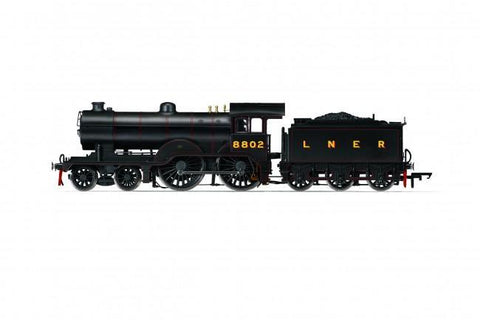
Hornby R3521 LNER 4-4-0 '8802', D16/3 Class
A popular and successful design of 4-4-0 tender engine, the first of the Great Eastern Railway class S46 locomotives, No.1900 Claud Hamilton, left Stratford Works in March 1900 and was, at that point, the largest express locomotive on the GER. The design of the class is often credited to James Holden, Superintendent of the GER at the time, but he was out of the country during this period and it was actually Stratford Works Chief Draughtsman, Frederick V. Russell, who was responsible for most of the design work. An order for an additional forty locomotives followed, built between 1900 and 1903, which were classified by the GER as S46 (later to be re-classified as Class D14 by the London North Eastern Railwaye Very quickly the class became known as Clauds and further batches were produced between 1904 and 1911, these were fitted with Belpaire boilers and classified as D56 (which were later to become Class D15e The final batch of ten engines, this time classified by the GER as H88, were built just after Grouping and fitted with 5 1inch diameter superheated Belpaire boilers, leading to them being aptly named Super Clauds and classified as Class D16 by the LNER. Following introduction, the Clauds went to work on the Great Easterns mainline express services, working to tight timings and ever increasing train loads, sometimes upwards of 400 tons. Even as the B12 class locomotives gained a foothold on the heavier expresses, the Clauds still worked many of the main routes, notably Cambridge to Liverpool Street and mainline services to Colchester, Ipswich and Norwich. Following the successful rebuilding of the B12 class to B12/3, a similar scheme was proposed to modernise the Clauds and in 1933, Sir Nigel Gresley rebuilt the first locomotive, No.8848. It was found that new, LNER style cabs had to be fitted to suit the larger superheated round topped boilers, as well as the decorative valancing needing removal and the footplate simplified. Out of the 121 locomotives built, 117 Clauds made it to Nationalisation in 1948 and by 1949, when rebuilding of the class ceased, 104 engines had been converted to D16/3. The withdrawal of the D16/3 class actually commenced in 1945, but they were still being used quite extensively on the Eastern region, even making it up to Cheshire. From 1955, the rate of withdrawal increased and No.62613 was the last to be withdrawn, from March Shed, in October 1960. None, sadly, were preserved. Locomotive No.8802 was one of the D15s rebuilt by Gresley as a D16/3 in April 1933. Built at Stratford Works in 1910, the locomotive entered traffic as GER No.1802 in September that year, allocated to Cambridge Shed. Renumbered as 8802 in August 1924, the locomotive was allocated to Stratford in March 1926, until May 1928 when it moved to Norwich. Throughout the rest of its working life, 8802 shuttled between allocations to Norwich, Yarmouth, Yarmouth Beach and Lowest oft Sheds, being renumbered as 2593 in the late LNER process, before taking 62593 under British Railways. Maximum curve Hornby 2nd radius + / 438mm+; Gauge 00; Length 216mm; DCC Type DCC Ready; Livery/owner LNER; Class D16/3; Designer James Holden; Entered Service 1930s; Age Suitability 14+; Motor 5 Pole Skew Wound. Loco Drive Wheel Configuration 4-4-0
R3521
